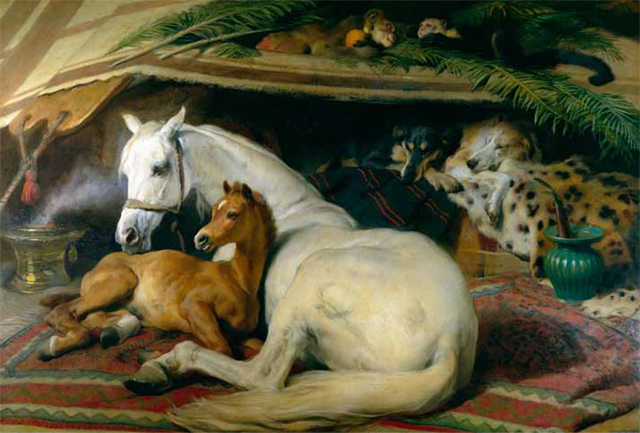My Favourite Painting: Henrietta, Duchess of Bedford
Henrietta, The Duchess of Bedford, chooses her favourite painting for Country Life.


The Arab Tent, about 1865/66, 61in by 89in, by Sir Edwin Landseer (1802–73), Wallace Collection, London. Bridgeman Images.
The Duchess of Bedford says: 'I was about 12 the first time I saw this painting at the Wallace Collection. As a child, I found it utterly magical, and I still do–the composition, the emotion, the feeling that comes across. I have had a print of it in every house I have ever lived in and it is the picture in the entire world I would most like to own. I can never tire of looking at it. The monkeys, the dogs, the furnishings: it represents to me the whole meaning of love, home, warmth and affection.'
The Dowager Duchess of Bedford is a leading racehorse owner and breeder.
Art critic John McEwen comments: 'Landseer was the youngest son of the seven surviving children of John Landseer, an associate engraver of the Royal Academy. His father was a deaf, ear-trumpet wielding, cantankerous, opinionated, and, therefore, unpopular agitator for engravers to have full academic status. His children were devoted to him and he took great pride in them. He subjected them to a rigorous artistic training from a young age and eagerly promoted their careers.
Only one married and all but two were artists. Edwin was the most talented. From when he was four, his drawings, mostly of animals, were assiduously dated and annotated by his father, who persuaded B. R. Haydon, friend of Keats and champion of ‘history painting’, to accept the Landseer boys as pupils. At 14, Edwin entered the Royal Academy Schools; soon after, he was a regular contributor to the Summer Exhibition and by 15 was attracting the attention of the leading collectors of the day. His professional advance to be Queen Victoria’s Court painter was matched by his social ascent as a wit, mimic, dandy and sportsman. ‘Rely on seeing you with your gun for the last ten days of shooting,’ wrote the 6th Duke of Bedford, the most important of his early patrons.
It was said Landseer had at least one child by the Duke’s second wife, Georgiana, a confidante until her death in 1853. In his last decade, he painted a number of horse subjects. The Arab Tent (exhibited in 1866 as Mare and Foal—Indian Tent) in equal measure displays his humour, love of animals and mastery at conveying various textures.'
This article was first published in Country Life, August 22, 2012
Sign up for the Country Life Newsletter
Exquisite houses, the beauty of Nature, and how to get the most from your life, straight to your inbox.
Country Life is unlike any other magazine: the only glossy weekly on the newsstand and the only magazine that has been guest-edited by HRH The King not once, but twice. It is a celebration of modern rural life and all its diverse joys and pleasures — that was first published in Queen Victoria's Diamond Jubilee year. Our eclectic mixture of witty and informative content — from the most up-to-date property news and commentary and a coveted glimpse inside some of the UK's best houses and gardens, to gardening, the arts and interior design, written by experts in their field — still cannot be found in print or online, anywhere else.
-
 Six rural properties with space, charm and endless views, as seen in Country Life
Six rural properties with space, charm and endless views, as seen in Country LifeWe take a look at some of the best houses to come to the market via Country Life in the past week.
By Toby Keel
-
 Exploring the countryside is essential for our wellbeing, but Right to Roam is going backwards
Exploring the countryside is essential for our wellbeing, but Right to Roam is going backwardsCampaigners in England often point to Scotland as an example of how brilliantly Right to Roam works, but it's not all it's cracked up to be, says Patrick Galbraith.
By Patrick Galbraith
-
 My favourite painting: Allan Mallinson
My favourite painting: Allan MallinsonMilitary historian Allan Mallinson picks an image of 'faith, generosity and ultimate sacrifice'.
By Charlotte Mullins
-
 My Favourite Painting: Piet Oudolf
My Favourite Painting: Piet Oudolf'One cannot sense whether he is far out on the ocean or closer to shore, or what he may be watching or feeling in that moment as he stares towards the beach.’
By Country Life
-
 My Favourite Painting: Mary Plazas
My Favourite Painting: Mary Plazas'There is compassion, awe, humility, a knowing yet a questioning in the glistening eyes. It moves me, it inspires me beyond the need to know.’
By Country Life
-
 My favourite painting: Robert Kime
My favourite painting: Robert KimeRobert Kime shares his fondness for New Year Snow by Ravilious
By Country Life
-
 My Favourite Painting: Anna Pavord
My Favourite Painting: Anna PavordAnna Pavord chooses a picture which reminds her of where she grew up
By Country Life
-
 My favourite painting: The Duchess of Wellington
My favourite painting: The Duchess of WellingtonThe Duchess of Wellington chooses her favourite painting for Country Life.
By Country Life
-
 My favourite painting: Maureen Lipman
My favourite painting: Maureen LipmanMaureen Lipman chooses her favourite painting for Country Life.
By Country Life
-
 My favourite painting: Jacqueline Wilson
My favourite painting: Jacqueline Wilson'I looked at this painting and decided to write about a Victorian circus girl one day'
By Country Life